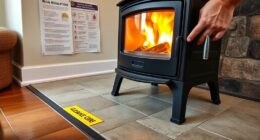Hello! Have you ever struggled to clean stubborn buildup from the glass on your wood stove? Don’t worry, I have the perfect solution for you.
In this article, I’ll walk you through step-by-step methods using natural cleaning solutions and commercial products to tackle the problem head-on.
Plus, I’ll share some tips on preventing future build-up.
So, grab your cleaning supplies and let’s get those windows sparkling again!
Key Takeaways
- Incomplete combustion of wood leads to gunk on wood stove windows.
- Vinegar and baking soda are effective natural cleaning solutions for removing gunk.
- Commercial cleaning products are efficient and quick in removing gunk from wood stove windows.
- Regular cleaning and applying a protective coating can prevent future gunk build-up.
Understanding the Causes of Gunk Build-Up
I’m trying to figure out why gunk keeps building up on my wood stove windows. It’s quite frustrating to constantly have to clean them, and I’m curious to know what causes this accumulation of gunk.
After doing some research, I’ve discovered that there are a few factors that contribute to this issue.
First, the primary cause of gunk on wood stove windows is the incomplete combustion of wood. When the wood doesn’t burn completely, it produces smoke and other byproducts that can stick to the glass.
Additionally, the quality of wood being burned can also impact the amount of gunk that accumulates. Wet or resinous wood tends to create more gunk compared to dry hardwood.
The presence of creosote in the chimney can also contribute to gunk accumulation. This gunk can obstruct the flow of air and affect the overall performance of the wood stove.
It’s important to regularly clean the windows to ensure optimal performance and to prevent any potential hazards.
Gathering the Necessary Supplies
To effectively clean the gunk off wood stove windows, I’ll need some vinegar and a microfiber cloth.
Here are three items you’ll need to gather for the task:
-
Vinegar: Vinegar is a powerful cleaning agent that can effectively remove stubborn stains and residue from wood stove windows. Its acidic properties help break down the gunk, making it easier to wipe away.
-
Microfiber cloth: A microfiber cloth is an essential tool for cleaning wood stove windows. Its fine fibers are gentle on the glass surface and help to remove dirt and grime without scratching or leaving streaks.
-
Alternative cleaning methods: In addition to vinegar, there are alternative cleaning methods you can try. Baking soda mixed with water forms a paste that can be used to scrub away stubborn stains. Another option is using a commercial glass cleaner that’s safe for use on wood stove windows.
Method 1: Using Natural Cleaning Solutions
One option for cleaning the gunk off wood stove windows is by using vinegar or baking soda, both of which can be effective and natural solutions.
To use a vinegar solution, mix equal parts of white vinegar and water in a spray bottle. Spray the solution onto the gunked-up window and let it sit for a few minutes. Then, scrub the window with a soft brush or sponge to remove the gunk. Rinse the window with water and dry it thoroughly.
Another option is to make a baking soda paste by mixing baking soda with water until it forms a thick paste. Apply the paste to the gunked-up window and let it sit for a few minutes. Then, scrub the window with a soft brush or sponge. Rinse the window with water and dry it thoroughly.
Transitioning into the next section about ‘method 2: using commercial cleaning products’, sometimes natural solutions may not be strong enough to remove stubborn gunk. In such cases, using commercial cleaning products specifically designed for wood stove windows can be an effective alternative.
Method 2: Using Commercial Cleaning Products
Sometimes natural solutions may not be strong enough, but using commercial cleaning products can effectively remove stubborn gunk from wood stove windows. Here are three reasons why using commercial cleaning products is a good alternative:
-
Powerful Abrasives: Commercial cleaning products often contain abrasive cleaners that can easily tackle tough gunk on wood stove windows. These abrasives work by gently scrubbing away the build-up without damaging the glass surface.
-
Efficient and Quick: Unlike natural solutions that may require multiple applications and lots of scrubbing, commercial cleaning products are designed to work quickly and efficiently. They can cut through the gunk in no time, saving you time and effort.
-
Varied Formulas: Commercial cleaning products come in a wide range of formulas, allowing you to choose the one that suits your specific needs. Whether you prefer a foam, spray, or liquid cleaner, there’s a commercial product available for you.
Preventing Future Gunk Build-Up
I can prevent future gunk build-up by regularly cleaning and applying a protective coating to my wood stove windows. By following these long term maintenance tips, I can ensure that my wood stove windows stay clean and clear for years to come. Here are some common mistakes to avoid when maintaining wood stove windows:
| Long Term Maintenance Tips | Common Mistakes to Avoid |
|---|---|
| Clean windows regularly | Using abrasive cleaners |
| Use a non-abrasive cleaner | Scrubbing too hard |
| Apply a protective coating | Using sharp objects to scrape off gunk |
Regular cleaning is essential to prevent gunk build-up on wood stove windows. Using a non-abrasive cleaner and a soft cloth, gently wipe away any residue. Avoid using abrasive cleaners as they can damage the glass. Applying a protective coating, such as a heat-resistant window treatment, helps prevent gunk from sticking to the glass. Lastly, never use sharp objects to scrape off the gunk, as this can lead to scratches and damage. By following these tips and avoiding common mistakes, you can keep your wood stove windows clean and gunk-free for a long time.
Frequently Asked Questions
Can I Use Regular Household Glass Cleaner to Clean My Wood Stove Window?
Yes, I use regular household glass cleaner on my wood stove window. It effectively removes gunk, but there are alternative cleaners like vinegar or baking soda. To prevent buildup, avoid burning wet or unseasoned wood.
How Often Should I Clean My Wood Stove Window?
I clean my wood stove window every 1-2 weeks to prevent buildup. It’s not safe to use abrasive materials like steel wool as they can scratch the glass. Instead, I use a non-abrasive cleaner and a soft cloth.
Is It Safe to Use Abrasive Materials Like Steel Wool to Clean the Gunk off My Wood Stove Window?
Using abrasive materials like steel wool to clean wood stove windows can be safe if done carefully. However, it’s important to consider the pros and cons, such as the risk of scratching the glass.
Can I Use Vinegar and Water as a Natural Cleaning Solution for My Wood Stove Window?
Yes, you can use vinegar and water as a natural cleaning solution for wood stove windows. It is a safer alternative to abrasive materials like steel wool and effectively removes gunk without damaging the glass.
Are There Any Specific Precautions I Should Take When Using Commercial Cleaning Products on My Wood Stove Window?
When using commercial cleaning products on wood stove windows, it’s important to take precautions to avoid damaging the glass. Alternatively, natural cleaning solutions like vinegar and water can be effective and safer to use.
What is the best method for removing a wood stove insert?
When it comes to removing a wood stove insert, the best method involves taking precautionary measures to ensure safety. Start by disconnecting any electrical connections and shutting off the gas supply, if applicable. Next, carefully remove the stovepipe and venting system. Finally, enlist the help of an expert to dismantle the insert and safely remove it from your home.
Conclusion
In conclusion, removing gunk from wood stove windows can be easily achieved using natural cleaning solutions or commercial products. However, preventing future build-up is key to maintaining a clear and efficient view.
Did you know that a clean and well-maintained wood stove can increase its efficiency by up to 30%? By regularly cleaning the windows, you not only improve the aesthetic appeal but also ensure optimal performance, which can save you money on heating costs.
Growing up surrounded by the vast beauty of nature, Sierra was always drawn to the call of the wild. While others sought the comfort of the familiar, she ventured out, embracing the unpredictable and finding stories in the heartbeat of nature.
At the epicenter of every remarkable venture lies a dynamic team—a fusion of diverse talents, visions, and passions. The essence of Best Small Wood Stoves is crafted and refined by such a trio: Sierra, Logan, and Terra. Their collective expertise has transformed the platform into a leading authority on small wood stoves, radiating warmth and knowledge in equal measure.











